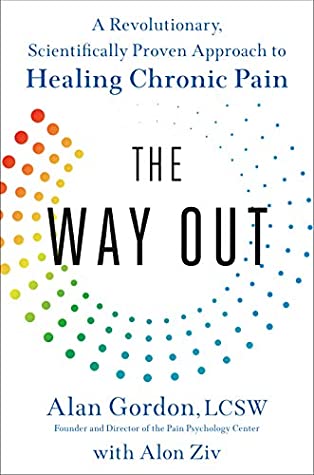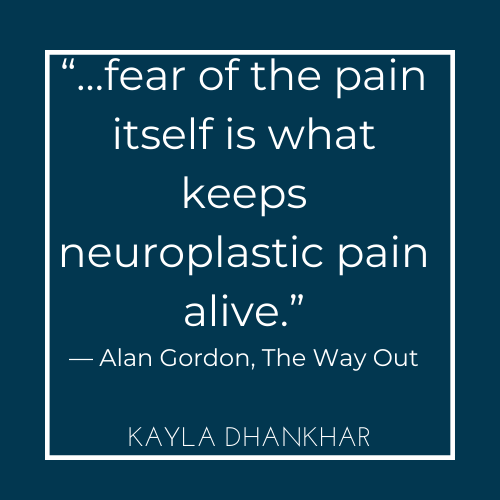“Are you willing to embrace the notion that you could be a pain-free person?” For a long time the answer for me here was no. I didn’t want to get my hopes up only to have them crushed again. I was so exhausted by the cycle of feeling better. Over and over I believed that maybe I could get out of chronic pain, only to fall again to another migraine. But I have to say, the information in this book, really may provide “The Way Out” if you find it at the right point in your life. If you are still with me right now, it might be time for you.
Background
In a nutshell, the idea behind “The Way Out” is that the chronic pain we experience is a learned program in our minds. It’s not that we made it up or it’s all in our heads. Rather a natural process that was designed to keep us safe, is instead setting off false alarms, day after day. It’s alerting us to danger, but the danger is gone. (This only applies to cases where there is no explainable physical cause, HOWEVER that includes many ‘diagnoses’ that may surprise you, so keep reading.)
Why we have pain

Imagine that you touch a hot stove, and you get burnt. That pain is your body’s way of teaching you that touching hot things is not safe. The pain is the alarm, telling you that there is danger. But it only sticks around for a short time while the fear of touching the hot stove remains because you know what that pain felt like.
In neuroplastic pain, it’s like the alarm is on high alert, or it’s going off for no reason at all. They are false alarms. But we feel we have to explain those alarms, so we look for physical problems that explain them. If there is no hot stove, we may point to hormone levels, or stress, or try to get a diagnosis that explains what’s happening. But if we could just retrain our brain to reduce the alarm signal, we could find the way out of chronic pain.
And when the brain believes that the body is damaged, it responds with pain. But when you can embrace a different belief—that the pain is due to your brain making a mistake and that your body is fine—then the fear goes away. And soon after, the pain fades.
Alan Gordon, “The Way Out”
The Role of Fear
A big part of this whole cycle of chronic pain is fear. According to Alan Gordon, regardless of the specifics, at a core level, all chronic pain patients have the same fear: “There has to be something going on in my body that’s causing this.” But what if there isn’t?
Research has been done about a variety of diagnoses based on MRIs that are often used to explain the cause of chronic pain. The studies show that those structural abnormalities show up in thousands of people who do not experience pain. This research proves that the chronic pain associated with those diagnoses can be neuroplastic, meaning it is learned in the brain and there is a way out. We all want words that explain what is going on with our bodies, “But there’s a downside to these medical diagnoses. They reinforce the idea that there’s something wrong with your body, even if there isn’t.” Having a diagnosis does not mean that this process will not work for you.
Of course, this is very oversimplified, and my intention here is not to replace this book for you but really to encourage you to read it if you experience chronic pain. If you would like to hear from more people who have benefitted from the process talked about in this book, you can check out the documentary “This Might Hurt” and this podcast with the author of the book, Alan Gordon and Mayim Bialik.
The Way Out of Chronic Pain
These three points have been key for me in understanding what has been happening for the last 18 years for me with migraine:

- “Over millions of years of evolution, we’ve been wired to link physical pain with physical injury in order to protect ourselves.
- “Our brains are telling us, “There’s something wrong with your body!” Even though there isn’t.”
- To overcome this barrier, we need to embrace a perspective that’s counterintuitive: “My pain makes me feel like I have a physical injury, but in this case, it’s actually a false alarm.”
This makes sense to my logical brain, and now I have actually experienced the evidence that it is true. Gordon suggests that when symptoms follow a pattern where they’re better or worse depending on the time of day, that points to neuroplastic pain. This makes sense to me because a physical abnormality would likely be steady. My pain generally has lots of ebbs and flows.
It’s important to find evidence that helps you boost your belief that your pain is neuroplastic. That’s because when the brain believes that the body is damaged, it responds with pain. So when you can embrace a different belief—that the pain is due to your brain making a mistake and that your body is fine—then the fear goes away. And soon after, the pain fades, or your experience of it changes.
These points are the core of what convinced me that there is a way out of chronic pain.
Pain Reprocessing Therapy
Pain reprocessing therapy acknowledges the experience of pain, but it does not validate it by claiming there is something physically wrong with the body anymore. Perhaps an injury occurred at one time, but Gordon says, “We may develop wear and tear, we may suffer injuries, but our bodies are quite robust and resilient.” Long term pain is often caused by our neural pathways being wired for fear.
“We need to eliminate your fear. We need to teach your brain that pain is not dangerous. This is the first goal of Pain Reprocessing Therapy. “Reprocessing” means changing the way your brain interprets the pain.”
Alan Gordon, The Way Out
Pain reprocessing therapy is about noticing the fear thought, choosing not to buy into it, and sending yourself a message of safety. For myself, this looks like noticing I have a sensation that feels like it could be the start of a migraine. But then, I do not buy into it. I tell myself, this sensation is just a sensation. I watch it and try to give it some characteristics like color and shape so I can notice when it moves or changes. This is somatic tracking. Then I tell myself, this sensation is safe. There is nothing wrong in my head. I am just experiencing a sensation and it’s not positive or negative, it just is.
It’s a practice not a cure
Sometimes the sensation moves or changes when I do this, and sometimes it doesn’t. But my experience of the sensation is always a little bit different the more times I do the exercise.
It’s important to go about this lightly because, “the harder we try to get rid of our pain, the more we reinforce that it’s dangerous.” If we are approaching the therapy to make the pain go away, we will only reinforce the idea that the pain is dangerous. But in my experience, the whole sensation I experience has not gone away. However, my experience of it has improved drastically. I experience the sensation as something small and manageable. I have no way of saying if it is actually less intense than it used to be or if it is my perception of it that has changed. But it doesn’t matter. The truth is, I am not losing time to migraine anymore. I can still function when I have the sensations.
Recommending The Way Out
If you are still here, then something about this is resonating with you. I highly recommend picking up this book. You can listen to it on audio, or learn more about neuroplastic pain in whatever way resonates most for you. The book is powerful and quite easy to read. If you want to have a chat about it, feel free to reach out.
Remember this is about empowering yourself. If there is a way out of chronic pain, wouldn’t you love to know about it?
Quotes
“The techniques in this book—practicing self-compassion, catching your fears, sending messages of safety—will help you build up your ability to bounce back from adversity.”
“This is the key to understanding neuroplastic pain. Being in a state of high alert can change the way we perceive signals from our body. Fear can create pain.”
“Of course, overcoming the fear of your pain is easier said than done. Pain is inherently scary. It’s hard not to be afraid of something that hurts! But when you can respond to your pain without fear, you’ll calm your brain, expose the false alarm, and deactivate your pain.”
“…fear of the pain itself is what keeps neuroplastic pain alive.”
“To recap, when you have neuroplastic pain, the fear you feel around the pain reinforces that it’s dangerous, and the pain persists. Which leads to more fear. Which leads to more pain. And the cycle continues.”
“We don’t just want to change your relationship with fear around your pain. We want to change your relationship with all fear.”
“The key to staying out of pain is the same as the key to getting out of pain: you want to make your brain feel safe.”
